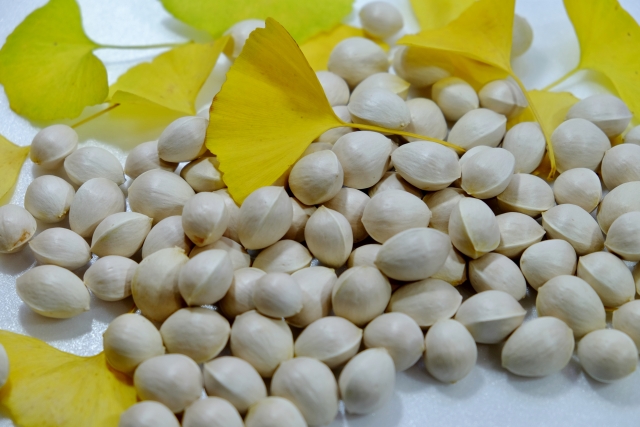紅葉(こうよう)の季節(きせつ)。色づくいちょうを見て楽しむ?それとも「ぎんなん」を食べるのが楽しみ?今回は「ぎんなん」について話しましょう。
日本語と英語で、よんでみよう!
ぎんなん拾(ひろ)いに行ったら思ったよりたくさん採(と)れちゃった。嫌(いや)な臭(にお)いがするんだけど、どうやったら食べられるの?
I went to pick up ginkgo nuts. This time, I could get more than I expected. However, they are stinky. I am wondering how can I eat these ginkgoes?
まず、1週間ぐらいバケツの水につけておいて。すると皮(かわ)が柔(やわ)らかくなってむけるようになるよ。その後、よく乾(かわ)かしてね。
First, soak them in a bucket of water for about 1 week to soften the coat. Then remove the outer skin and the pith. Dry them well afterwards.
ああ、見たことある。日の当たる昼間に、ぎんなんの実を網(あみ)に並(なら)べて外に干(ほ)すんだよね。
Yeah, I have seen that! Ginkgo nuts are then spread on the net and dried in the sun, right?
準備(じゅんび)ができたら、フライパンで炒(い)って塩(しお)をつけてそのまま食べてもいいし、茶碗蒸(ちゃわんむ)しに入れてもおいしいよ。
When they are ready, it’s okay to roast them in a pan and eat them seasoning with salt. It’s also delicious to put in Chawanmushi, pot-steamed hotchpotch.
もっとくわしく!
In autumn, trees turn from beautiful green into yellow, orange and shiny bright red.
(秋には木々が美しい緑から黄色、橙色、そして赤色に明るく輝きます。)
今回取り上げた「ぎんなん」がなる銀杏(イチョウ)の木は英語でginkgo treeと言います。ほかにも、秋が観賞期になっているいろいろな木があります。
英語では何と言うでしょうか?
- 楓(カエデ): maple (tree)
- 柿:(Japanese) persimmon tree
- クヌギ: oak tree
- クロマツ:Japanese black pine
- アカマツ:Japanese red pine
- ウバメガシ:ubame oak
- 杉:Japanese cedar
- 欅(けやき): (Japanese) zelkova
- 栗:chestnut tree
知っている名前はありましたか?「栗」は小さいころ、Under the spreading chestnut tree(大きな栗の木の下で)の歌で覚えた人もいるかもしれませんね。
















